
利率模型理论和实践 第2版(影印版) 世界图书出版公司北京公司
【保正版 出版社正版新书发货放心订购支持团购】
¥ 186.12 9.4折 ¥ 198 全新
库存4件
北京朝阳
认证卖家担保交易快速发货售后保障
作者(意)布里谷 著
出版社世界图书出版公司北京公司
ISBN9787510005602
出版时间2010-04
装帧精装
开本24开
页数1038页
定价198元
货号1202380519
上书时间2024-01-16
- 在售商品 暂无
- 平均发货时间 13小时
- 好评率 暂无
- 店主推荐
- 最新上架
商品详情
- 品相描述:全新
- 商品描述
-
内容简介
《利率模型理论和实践(第2版)(精)》是一部详细讲述利率模型的书,旨在将该领域的理论和实践联系起来,在第一版的基础上增加了许多新特征。有关LIBOR市场模型中的“Smile”部分得到了极大的丰富,已有内容扩充为几个新的章节。书中增加了瞬时相关矩阵的历史估计,局部波动动力学和随机波动模型,全面讲述了近期新发展较快的不确定波动率方法。跟膨胀有关的衍生品定价讲述的较为详细。读者对象:数学专业研究生、老师和经济、金融的相关人员。
目录
Preface
Motivation
Aims, Readership and Book Structure
Final Word and Acknowledgments
Description of Contents by Chapter
Abbreviations and Notation
Part I. BASIC DEFINITIONS AND NO ARBITRAGE
1. Definitions and Notation
1.1 The Bank Account and the Short Rate
1.2 Zero-Coupon Bonds and Spot Interest Rates
1.3 Fundamental Interest-Rate Curves
1.4 Forward Rates
1.5 Interest-Rate Swaps and Forward Swap Rates
1.6 Interest-Rate Caps/Floors and Swaptions
2. No-Arbitrage Pricing and Numeraire Change
2.1 No-Arbitrage in Continuous Time
2.2 The Change-of-Numeraire Technique
2.3 A Change of Numeraire Toolkit(Brigo & Mercurio 2001c)
2.3.1 A helpful notation: "DC"
2.4 The Choice of a Convenient Numeraire
2.5 The Forward Measure
2.6 The Fundamental Pricing Formulas
2.6.1 The Pricing of Caps and Floors
2.7 Pricing Claims with Deferred Payoffs
2.8 Pricing Claims with Multiple Payoffs
2.9 Foreign Markets and Numeraire Change
Part II. FROM SHORT RATE MODELS TO HJM
3. One-factor short-rate models
3.1 Introduction and Guided Tour
3.2 Classical Time-Homogeneous Short-Rate Models
3.2.1 The Vasicek Model
3.2.2 The Dothan Model
3.2.3 The Cox, Ingersoll and Ross (CIR) Model
3.2.4 Affine Term-Structure Models
3.2.5 The Exponential-Vasicek (EV) Model
3.3 The Hull-White Extended Vasicek Model
3.3.1 The Short-Rate Dynamics
3.3.2 Bond and Option Pricing
3.3.3 The Construction of a Trinomial Tree
3.4 Possible Extensions of the CIR Model
3.5 The Black-Karasinski Model
3.5.1 The Short-Rate Dynamics
3.5.2 The Construction of a Trinomial Tree
3.6 Volatility Structures in One-Factor Short-Rate Models
3.7 Humped-Volatility Short-Rate Models
3.8 A General Deterministic-Shift Extension
3.8.1 The Basic Assumptions
3.8.2 Fitting the Initial Term Structure of Interest Rates
3.8.3 Explicit Formulas for European Options
3.8.4 The Vasicek Case
3.9 The CIR++ Model
3.9.1 The Construction of a Trinomial Tree
3.9.2 Early Exercise Pricing via Dynamic Programming
3.9.3 The Positivity of Rates and Fitting Quality
3.9.4 Monte Carlo Simulation
3.9.5 Jump Diffusion CIR and CIR++ models (JCIR, JCIR++)
3.10 Deterministic-Shift Extension of Lognormal Models
3.11 Some Further Remarks on Derivatives Pricing
3.11.1 Pricing European Options on a Coupon-Bearing Bond
3.11.2 The Monte Carlo Simulation
3.11.3 Pricing Early-Exercise Derivatives with a Tree
3.11.4 A Fundamental Case of Early Exercise: BermudanStyle Swaptions.
3.12 Implied Cap Volatility Curves
3.12.1 The Black and Karasinski Model
3.12.2 The CIR++ Model
3.12.3 The Extended Exponential-Vasicek Model
3.13 Implied Swaption Volatility Surfaces
3.13.1 The Black and Karasinski Model
3.13.2 The Extended Exponential-Vasicek Model
3.14 An Example of Calibration to Real-Market Data Two-Factor Short-Rate Models
4.1 Introduction and Motivation
4.2 The Two-Additive-Factor Gaussian Model G2++
4.2.1 The Short-Rate Dynamics
4.2.2 The Pricing of a Zero-Coupon Bond
4.2.3 Volatility and Correlation Structures in Two-Factor Models
4.2.4 The Pricing of a European Option on a Zero-Coupon Bond
4.2.5 The Analogy with the Hull-White Two-Factor Model
4.2.6 The Construction of an Approximating Binomial Tree
4.2.7 Examples of Calibration to Real-Market Data
4.3 The Two-Additive-Factor Extended CIR/LS Model CIR2++
4.3.1 The Basic Two-Factor CIR2 Model
4 3 2 Relationship with the Longstaff and Schwartz Model (LS)
4.3.3 Forward-Measure Dynamics and Option Pricing for CIR2
4.3.4 The CIR2++ Model and Option Pricing
5. The Heath-Jarrow-Morton (HJM) Framework
5.1 The HJM Forward-Rate Dynamics
5.2 Markovianity of the Short-Rate Process
5.3 The Ritchken and Sankarasubramanian Framework
5.4 The Mercurio and Moraleda Model
Part III. MARKET MODELS
6. The LIBOR and Swap Market Models (LFM and LSM)
6.1 Introduction
6.2 Market Models: a Guided Tour.
6.3 The Lognormal Forward-LIBOR Model (LFM)
6.3.1 Some Specifications of the Instantaneous Volatility of Forward Rates
6.3.2 Forward-Rate Dynamics under Different Numeraires
6.4 Calibration of the LFM to Caps and Floors Prices
6.4.1 Piecewise-Constant Instantaneous-Volatility Structures
6.4.2 Parametric Volatility Structures
6.4.3 Cap Quotes in the Market
6.5 The Term Structure of Volatility
6.5.1 Piecewise-Constant Instantaneous Volatility Structures
6.5.2 Parametric Volatility Structures
6.6 Instantaneous Correlation and Terminal Correlation
6.7 Swaptious and the Lognormal Forward-Swap Model (LSM)
6.7.1 Swaptions Hedging
6.7.2 Cash-Settled Swaptions
6.8 Incompatibility between the LFM and the LSM
6.9 The Structure of Instantaneous Correlations
6.9.1 Some convenient full rank parameterizations
6.9.2 Reduced-rank formulations: Rebonato's angles and eigen- values zeroing
6.9.3 Reducing the angles
6.10 Monte Carlo Pricing of Swaptions with the LFM
6.11 Monte Carlo Standard Error
6.12 Monte Carlo Variance Reduction: Control Variate Estimator
6.13 Rank-One Analytical Swaption Prices
6.14 Rank-r Analytical Swaption Prices
6.15 A Simpler LFM Formula for Swaptions Volatilities
6.16 A Formula for Terminal Correlations of Forward Rates
6.17 Calibration to Swaptions Prices
6.18 Instantaneous Correlations: Inputs (Historical Estimation) or Outputs (Fitting Parameters)?
6.19 The exogenous correlation matrix
6.19.1 Historical Estimation
6.19.2 Pivot matrices
6.20 Connecting Caplet and S x 1-Swaption Volatilities
6.21 Forward and Spot Rates over Non-Standard Periods
6.21.1 Drift Interpolation
6.21.2 The Bridging Technique
7. Cases of Calibration of the LIBOR Market Model
7.1 Inputs for the First Cases
7.2 Joint Calibration with Piecewise-Constant Volatilities as in TABLE 5
7.3 Joint Calibration with Parameterized Volatilities as in Formulation 7
7.4 Exact Swaptions "Cascade" Calibration with Volatilities as in TABLE 1
7.4.1 Some Numerical Results
7.5 A Pause for Thought
7.5.1 First summary
7.5.2 An automatic fast analytical calibration of LFM to swaptions. Motivations and plan
7.6 Further Numerical Studies on the Cascade Calibration Algorithm
……
8.Monte Carlo Tests for LFM Analytical Approximations
Part IV.THE VOLATILITY SMILF
9.Including the Smile in the LFM
10.Local-Volatility Models
11.Stochasti-Volatility Models
12.Uncertain-Parameter Models
Part V.EXAMPLES OF MARKET PAYOFFS
13.Pricing Derivatives on a Single Interest-Rate Curve
14.Pricing Derivatives on Two Interest-Rate Curves
Part VI.INFLATION
15.Pricing of Inflation-Indexed Derivatives
16.Inflation Indexed Swaps
17.Inflation-Indexed Caplets/Floorlets
18.Calibration to market data
19.Introducing Stochastic Volatility
20.Pricing Hybrids with an Inflation Component
Part VII.CREDIT
21.Introduction and Pricing under Counterparty Risk
22.Intensity Models
23.CDS Options Market Models
Part VIII.APPENDICES
A.Other Interest-Rate Models
B.Pricing Equity Derivatives under Stochastic Rates
C.A Crash Intro to Stochastic Differential Equations and Poisson Processes
D.A Useful Calculation
E.A Second Useful Calculation
F.Approximating Diffusions with Trees
G.Trivia and Frequently Asked Questions
H.Talking to the Traders
References
Index
相关推荐
— 没有更多了 —

















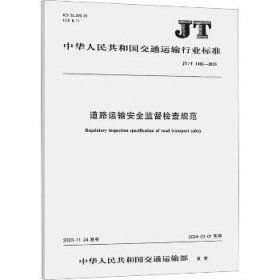



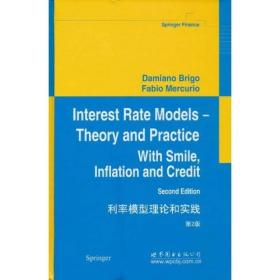
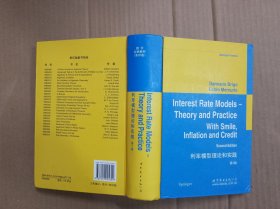


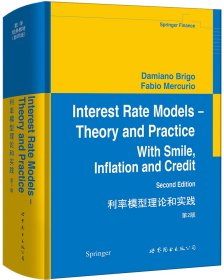
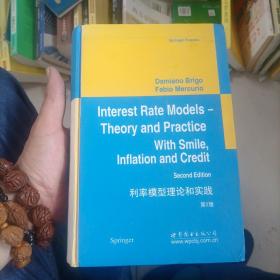
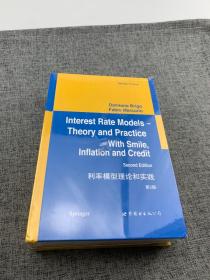

以下为对购买帮助不大的评价